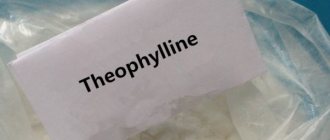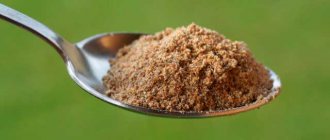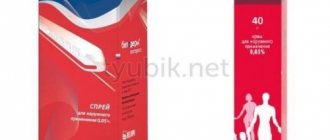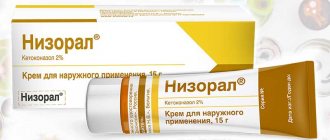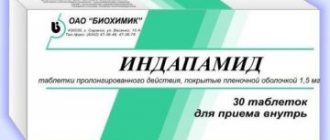Release form and composition
- Tablets (10 or 20 pieces in blisters, in a cardboard pack of 1, 2, 3, 4, 5, 6 or 9 packages; 10, 20, 30, 40, 50, 60, 80, 90, 100, 120 or 180 pieces in polymer cans, one can in a cardboard pack);
- Capsules: size No. 1, cylindrical, matte surface, smooth, hemispherical edges, capsule color: white body and blue cap, blue body and cap, blue body and blue cap; the contents of the capsule are white or yellowish-white powder (10 capsules in a blister, 1, 2 or 3 blisters in a cardboard package).
1 tablet contains:
- Active ingredient: spironolactone – 25 mg;
- Auxiliary components: copovidone, talc, microcrystalline cellulose, potato starch, crospovidone, calcium stearate.
1 capsule contains the active ingredient: spironolactone – 50 mg or 100 mg.
Veroshpiron recipe
Quite often, it is not a prescription for spironolactone that is prescribed, but a prescription for veroshpiron. The active ingredients of these drugs are the same.
At a dosage of 25 mg
- Rp. Tab “Verospiron” 25 mg N 30 DS Orally 1 tablet 2 times a day
- Rp. Tab “Verospiron” 0.025 N 30 DS Orally 1 tablet 2 times a day
At a dosage of 50 mg
- Rp. Tab “Verospiron” 50 mg N 30 DS Orally 1 tablet 1 time per day
- Rp. Tab “Verospiron” 0.05 N 30 DS Orally 1 tablet 1 time per day
At a dosage of 100 mg
- Rp. Tab “Verospiron” 100 mg N 30 DS Orally 1 tablet 1 time per day
- Rp. Tab “Verospiron” 0.1 N 30 DS Orally 1 tablet 1 time per day
Indications for use
- Edema syndrome in CHF (chronic heart failure) (in complex treatment or as monotherapy);
- Hypomagnesemia/hypokalemia (as an adjuvant to prevent this condition while taking diuretics, if other methods of correcting potassium levels are not possible);
- Essential hypertension (as part of complex treatment);
- Conn's syndrome (primary hyperaldosteronism) (before surgery as a short course of treatment);
- Conditions in which secondary hyperaldosteronism is possible, including nephrotic syndrome, cirrhosis of the liver, accompanied by edema and/or ascites, and other conditions leading to edema;
- Diagnosis of primary hyperaldosteronism.
Spironolactone analogues
Spironolactone is a potassium-sparing diuretic. Refers to synthetic aldosterone antagonists. Below are the most common analogues of spironolactone in Latin:
- Verospiron
- Aldactone
- Spironol
Spironolactone is included in combination drugs with thiazide diuretics, often with altizide for the treatment of edema and hypertension
- Aldactazide
- Aldactazine
- Aldactatide,
- Aldozone,
- Altexide,
- Practazin,
- Prinactizide
- Spiroctazine.
Contraindications
- Severe chronic renal failure (with creatinine clearance less than 10 ml/min);
- Hyponatremia;
- Addison's disease;
- Anuria;
- Hyperkalemia;
- Pregnancy period, for capsules – first trimester;
- Breastfeeding period;
- Children under three years of age;
- Lactase deficiency, lactose intolerance, glucose-galactose malabsorption (for tablets);
- Hypersensitivity to the main or auxiliary components of the drug.
In the second and third trimester of pregnancy, Spironolactone capsules can be taken only under strict indications, when the expected effect of therapy outweighs the potential risk to the fetus.
Directions for use and dosage
Tablets Spironolactone tablets are taken orally.
Recommended doses and duration of treatment for adult patients:
- Essential hypertension: 50-100 mg per day once; it is possible to gradually (once every two weeks) increase the daily dose to 200 mg. To achieve a therapeutic effect, the drug is taken for at least two weeks. If necessary, the dose is adjusted;
- Severe hyperaldosteronism and hypokalemia: 300 mg per day in 2-3 doses; then, as the condition improves, the dose of the drug is gradually reduced to 25 mg per day;
- Idiopathic hyperaldosteronism: 100-400 mg per day;
- Hypomagnesemia/hypokalemia caused by taking diuretics: 25-100 mg per day in several doses or once. The maximum dose is 400 mg per day;
- Diagnosis of primary hyperaldosteronism: a short diagnostic test - 400 mg per day in several doses for 4 days (if the potassium level increases while taking Spironolactone and decreases after its discontinuation, the presence of the disease can be assumed); long-term diagnostic test - 400 mg per day in several doses for 3-4 weeks (if arterial hypertension and hypokalemia are corrected, primary hyperaldosteronism can be assumed);
- Preoperative treatment of primary hyperaldosteronism: 100-400 mg per day in 1-4 doses throughout the entire period of preparation for surgery; if surgery is not indicated, Spironolactone is prescribed in a maintenance minimum effective dose, determined individually;
- Edema due to nephrotic syndrome: 100-200 mg per day;
- Edema due to CHF: 100-200 mg per day in 2-3 doses for 5 days; Thiazide and loop diuretics are prescribed simultaneously. Subsequently, depending on the effectiveness of the drug, the daily dose is reduced to 25 mg. The maximum dose is 200 mg per day; supportive – selected individually;
- Edema due to liver cirrhosis: 100 mg per day if the Na+/K+ ratio in the urine is more than 1.0; 200-400 mg per day with a Na+/K+ ratio of less than 1.0. The maintenance dose is selected individually.
For children with edema, the drug is prescribed at an initial dose of 1-3.3 mg/kg body weight (or 30-90 mg/m2) per day in 1-4 doses. After 5 days, the dose is adjusted, increasing it, if necessary, three times compared to the initial one.
Capsules Spironolactone capsules are taken orally.
The dosage regimen is determined individually by the attending physician.
Recommended standard doses for adult patients: 25-200 mg/day once or divided into several doses; if necessary, the dose can be increased to 400 mg/day.
For children, the drug is usually prescribed at a dose of 3 mg/kg/day, once or divided into two doses.
Side effects
- Digestive system: gastritis, vomiting, nausea, intestinal colic, abdominal pain, liver dysfunction, bleeding and ulceration of the gastrointestinal tract, constipation or diarrhea;
- Nervous system: drowsiness, ataxia, confusion, headache, lethargy, muscle spasms, dizziness, lethargy;
- Urinary system: hyperuricemia, increased urea concentration, acute renal failure, hypercreatininemia;
- Hematopoietic system: agranulocytosis, megaloblastosis, thrombocytopenia;
- Endocrine system: with long-term treatment - decreased potency, erectile dysfunction and gynecomastia in men; amenorrhea, hirsutism, dysmenorrhea, deepening of voice, breast carcinoma, metrorrhagia during menopause, breast tenderness and hypertrichosis in women;
- Metabolism: violation of the acid-base state and water-electrolyte metabolism;
- Dermatological reactions: baldness;
- Allergic reactions: drug fever, erythematous and maculopapular rash, skin itching;
- Other reactions: muscle spasms and cramps of the calf muscles.
SPIRONOLACTONE
SPIRONOLACTONE
(
Spironolactonum
; synonym:
veroshpiron, aldactone
, etc.) is a diuretic drug from the group of aldosterone antagonists. S. was synthesized by S. M. Kagawa in 1959 after studying biol. activity of a number of compounds of a steroid nature (see Steroids) that have an iropionic acid γ-lactone ring at the C17 atom—the so-called. spirolactones (see Lactones). These compounds exhibited the properties of aldosterone antagonists (see). S.'s advantage over other spirolactones is good absorption from the gland. tract and high biological activity. Thanks to these qualities, spironolactone was introduced into medical practice as a diuretic (see).
According to the chemical structure, S. is a gamma-lactone 3-(3-oxo-7-α-thioacetyl-17β-oxy-4-androsten-17α-yl)-propionic acid:
S.'s action is explained by its ability to compete with aldosterone and other steroids that have a mineralocorticoid effect (see Mineralocorticoid hormones) - deoxycorticosterone (see), corticosterone (see), hydrocortisone (see), for receptors in target cells, not thereby allowing mineralocorticoid hormones to have a stimulating effect on the transmembrane transport of Na+ ions (see Ion transport). In the kidneys (see) S. blocks the action of aldosterone in the distal parts of the nephron. Under the influence of S., sodium reabsorption decreases, which explains the increase in the release of Na+ and Cl- ions and the decrease in the release of K+ ions and urea (see). Thus, the diuretic effect of S. is associated with its natriuretic effect, therefore, when using S., the content of Na+ ions in the blood plasma decreases, and the content of K+ ions increases.
S. does not have an independent effect on water-salt metabolism (see). In an experiment on adrenalectomized rats in the absence of mineralocorticoids, S.'s effect was not observed. S.'s diuretic effect is most pronounced in hyperaldosteronism (see). Under the influence of S., there is also an increase in the Na+/K+ ratio in saliva, sweat, and feces. A decrease in the intracellular content of Na+ ions in the vessels and the associated decrease in vascular tone is one of the mechanisms of the hypotensive effect of S. In the body, S. is metabolized to form 17-ketosteroids (see), which are excreted in the urine.
Verospiron is used in the clinic
, coming to the USSR from Hungary. Indications for S.'s use are primary hyperaldosteronism, as well as conditions accompanied by secondary hyperaldosteronism, such as prolonged physical stress, liver cirrhosis with ascites, nephrotic syndrome, cardiovascular failure in the decompensation stage, hypertension, idiopathic edema, etc. The use of S. in primary hyperaldosteronism helps to normalize electrolyte balance and reduce blood pressure. In patients with normo- and hypotension, S. does not cause a decrease in blood pressure. The use of S. in combination with saluretics, hypothiazide, etc. enhances their diuretic effect, and also prevents the development of hypokalemia and refractoriness to these drugs, which is due to differences in the mechanisms of action of S. and these drugs.
The daily dose of S. can vary from 0.075 to 0.3 g. The usual therapeutic dose is 0.1 - 0.2 a (in 2-4 doses), when the desired effect occurs, it can be reduced to 0.075-0.025 g of the drug per day . The maximum effect of S. usually appears 2-3 days after the start of administration (sometimes after 5 days) and persists for 2-3 days after discontinuation of the drug.
Side effects
, arising from an overdose or prolonged use of S., are a consequence of hyperkalemia and hyponatremia and are expressed by the appearance of dizziness, general weakness, drowsiness, nausea, and skin rash.
The drug is contraindicated
in acute renal failure, chronic. nephritis, azotemia.
Release form:
tablets of 0.025 g (25 mg) of spironolactone in microionized form. Storage in a dry place protected from light.
Bibliography:
Komissarenko V.P. and Reznikov A.G. Inhibitors of adrenal gland function, Kyiv, 1972; G 1 ci z E. a. V e with sei P. Aldosterone, Budapest, 1971; Kagawa S. M., Sturtevant F. M. a. Van Arman S. G. Pharmacology of a new steroid that blocks salt activity of aldosterone and desoxycorticosterone, J. Pharmacol., exp. Ther., v. 126, p. 123, 1959.
V. S. Zelenetskaya.
special instructions
During treatment with Spironolactone, a (temporary) increase in serum urea nitrogen concentrations is possible, especially in cases of hyperkalemia and decreased renal function.
In case of renal and hepatic diseases and in elderly patients, it is necessary to regularly monitor renal function and serum electrolyte levels.
In diabetes mellitus, especially with diabetic nephropathy, the drug is used with caution, as hyperkalemia may develop.
Spironolactone makes it difficult to detect cortisol, adrenaline and digoxin in the blood.
When NSAIDs are used concomitantly, monitor electrolyte levels and renal function.
During treatment, it is advisable to avoid eating foods rich in potassium and do not drink alcohol.
At the beginning of Spironolactone therapy, it is prohibited to drive vehicles or perform any other potentially dangerous work that requires high concentration and quick reaction. The duration of such restrictions is set individually.
Interaction
Simultaneous administration enhances the effect of Gonadorelin, Buserelin and Triptorelin. Simultaneous use with lithium carbonate increases the concentration of lithium in the blood plasma, with cholestyramine - causes hypochloremic alkalosis, with eprosartan, losartan and candesartan - increases the risk of hyperkalemia.
Concomitant use with drugs containing potassium, as well as potassium-sparing diuretics, dietary supplements and table salt substitutes that contain potassium, leads to the development of hyperkalemia.
Drug interactions
Spironolactone reduces the effectiveness of direct and indirect anticoagulants and mitotane; increases the toxicity of lithium preparations; reduces the toxicity of cardiac glycosides; accelerates the metabolism of carbenoxolone and phenazole; increases the half-life of digoxin; enhances the effect of antihypertensive and diuretic drugs, buserelin, triptorelin and gonadorelin; reduces the sensitivity of blood vessels to norepinephrine.
Diuretics and glucocorticosteroids enhance and accelerate the natriuretic and diuretic effects of spironolactone, while nonsteroidal anti-inflammatory drugs reduce them.
When used concomitantly with potassium supplements, potassium supplements, angiotensin-converting enzyme inhibitors, potassium-sparing diuretics, aldosterone blockers, potassium-sparing diuretics, cyclosporine, angiotensin II antagonists and indomethacin, the risk of hyperkalemia increases.
Indomethacin and salicylates reduce the diuretic effect; fludrocortisone increases tubular secretion of potassium; carbenoxolone affects the ability of spironolactone to retain sodium (increases this ability).
When taken simultaneously with cholestyramine and ammonium chloride, hyperkalemic metabolic acidosis may develop.
Pharmacological properties of the drug Spironolactone
Spironolactone is a potassium-sparing diuretic with moderate natriuretic effects. The diuretic effect of spironolactone is due to its antagonism towards the adrenal hormone aldosterone. The antagonistic effect of spironolactone is manifested in the distal renal tubules: it reduces the excretion of potassium ions and enhances the excretion of sodium and water ions without disturbing the electrolyte balance; lowers the titratable acidity of urine and reduces the excretion of urea. Prevents the binding of aldosterone to cell protein receptors. After oral administration, spironolactone is rapidly absorbed from the digestive tract; about 90% of spironolactone is bound to plasma proteins. Bioavailability is 92–99% and increases when taken simultaneously with food, distributed in the liver, kidneys, adrenal glands and gonads. Spironolactone is rapidly metabolized in the liver. The main pharmacologically active metabolites are 7-α-thiospironolactone, 7-α-thiomethylspironolactone and canrenone. The antialdosterone effect is determined by canrenone, which makes up about 50% of all spironolactone metabolites. The maximum concentration of canrenone is reached 2–4 hours after administration of spironolactone, and its half-life averages 12.5 hours. Spironolactone has a cumulative effect. Its diuretic effect develops gradually and is observed on the 2nd–5th day of treatment. Penetrates through the placenta and into breast milk. It is excreted from the body in feces and urine.

